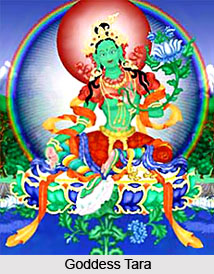 Goddess Tara in Hinduism has several forms that have been described in Hindu texts. She has been depicted as the fierce and terrifying goddess that bears resemblance with the Tara Kurukulla and Mahacina Tara of the Buddhist tradition. Even the other forms of Tara have been equally forbidding. Goddess Tara has been mentioned in the dhyana mantra in form of Nila Saraswati.
Goddess Tara in Hinduism has several forms that have been described in Hindu texts. She has been depicted as the fierce and terrifying goddess that bears resemblance with the Tara Kurukulla and Mahacina Tara of the Buddhist tradition. Even the other forms of Tara have been equally forbidding. Goddess Tara has been mentioned in the dhyana mantra in form of Nila Saraswati.
Goddess Tara has been description in the Hindu text emphasise two important features that have not been mentioned in the Buddhist text. One of them associate Tara with Goddess Kali whom she closely resembles. The second one located her in the cremation ground. Both of these characterisations associations reflect her petrifying nature.
Goddess Tara and Kali bear a strong resemblance in their two most common images i.e. Dakshina Kali and Ugra Tara. Both the images depict them standing on a supine image of Lord Shiva. The goddesses are black, blue black or dark blue in colour. They are either naked or seen wearing minimal clothes. They wear tiger skin, a necklace of corpse`s skull and also a girdle of severed arms. Both the images have are associated with the cremation ground and have a lolling tongue from which blood oozes out. They bear such strong resemblance that they are said to manifestations of each other. They even share many epithets of their thousand named hymns like Tara is also acknowledged as Kalika, Mahakali, Ugra Kali, Bhadra Kali. Even the famous devotional Bengali poet Ramprasad Sen of the eighteenth century used the name of Kali and Tara interchangeably.
In reference to Hindu text like Goddess Kali, Tara also enjoys the taste of blood and also welcomes the sacrifice of blood. Tara Tantra describes Tara`s delight in both the human as well as animal blood. Tara Tantra is described to be the part of Vamachara or left handed Tantric rites where meat, wine and the sexual union is prominent. Even in Mundamala Tantra Tara is associated with blood.
Goddess Tara is bonded with Lord Shiva and is often called as Sankara Vallabha, Hara Vallabha, Hara Patni and others. Like Kali Tara is also associated with the cremation ground. She is seen standing on a corpse which is cremated. She is also surrounded by jackals. She is thus also known as Smasana Bhairavi. Her temples are also located around cremation grounds. Thus in Hinduism Tara has been strongly associated with Kali and it is said that Tara takes the image of Kali during Pralaya.




















